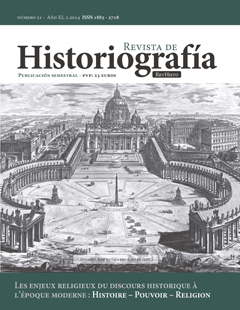Entre histoire et mythistoire: Edward Stillingfleet, Origines Britannicae (1685)
Resumen
Résumé: Dès ses origines au XVIe siècle, l’Église d’Angleterre se trouva dans l’obligation de justifier et de légitimer son existence, tant par rapport à l’Église romaine, que par rapport aux Églises dissidentes. La production d’histoires de l’Église d’Angleterre devant faire autorité relevait donc d’une nécessité, non seulement d’ordre religieux, mais aussi d’ordre politique, dans un pays dont le souverain était simultanément chef de l’État, et chef de l’Église. C’est dans ce contexte général, et déjà ancien, que s’inscrit l’oeuvre d’Edward Stillingfleet, qui se trouve toutefois pris entre deux exigences contradictoires : tenir compte des très réels progrès de la science historique, dûs entre autres à Le Nain de Tillemont et aux mauristes, sans complètement renoncer au mythe national protestant, et à sa composante fabuleuse et légendaire. Si l’ouvrage représente à certains égards un réel progrès du point de vue historiographique (l’Histoire des Écossais de Boèce est ainsi discréditée), Stillingfleet n’en utilise pas moins paradoxalement les nouvelles méthodes de la connaissance historique pour redonner lustre et crédit aux légendes, telle celle du roi Arthur, qu’elles devaient pourtant contribuer à dissiper. Les récits légendaires demeurent donc le noyau d’une histoire qui ne parvient jamais tout à fait à s’affranchir de la mythistoire.
Abstract: From its beginnings in the 16th century, the Church of England found itself compelled to justify and legitimize its very existence, to vindicate itself from the charge of illegitimacy levelled against it by both the Roman church and the Protestant dissenters (as they came to be known later). The writing of authoritative Church of England histories was therefore both a religious and a political necessity, as the English monarch was both head of state and head of the Church. Origines fits into this larger picture, but Stillingfleet had to meet at once two contradictory requirements : on the one hand, he had to take into account the major advances leading to the progressive transformation of history into a science (in particular thanks to Le Nain de Tillemont and the Maurists), while at the same time not completely shedding the national Protestant mythology, with all its attendant tales and legends. In some ways, Origines does mark a genuine advance in the field of historical knowledge – Hector Boethius’s Scotorum Historia is given short shrift – , but Stillingfleet paradoxically uses the new historical methods to shore up the very legends they were meant to dispel (such as that of King Arthur). The legendary tales remain at the heart of a history that never quite manages to set itself free from mythistory.
Mots clés: Edward Stillingfleet, Église d’Angleterre, presbytériens, catholiques, histoire nationale, histoire ecclésiastique, méthode historique, légendes, mythistoire.
Key words: Edward Stillingfleet, Church of England, presbyterians, catholics, national history, ecclesiastical history, historical method, legends, mythistory.
Descargas
Descargas
Publicado
Número
Sección
Licencia
El titular de los derechos de autor de los contenidos de esta revista es el Instituto de Historiografía "Julio Caro Baroja" de la Universidad Carlos III de Madrid.
